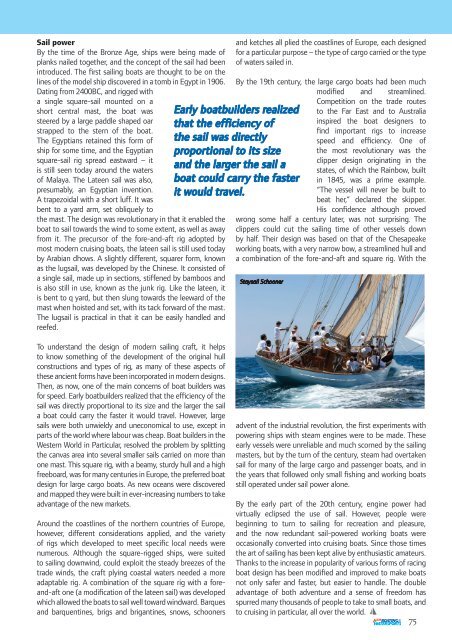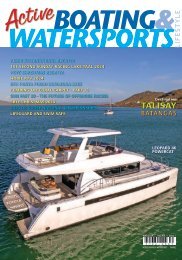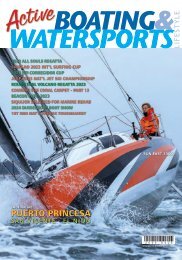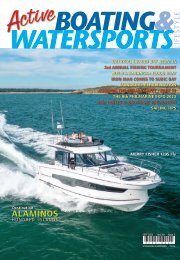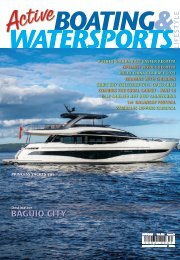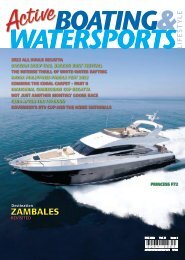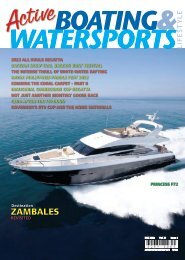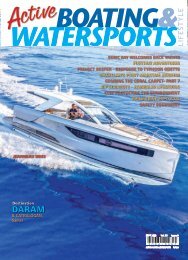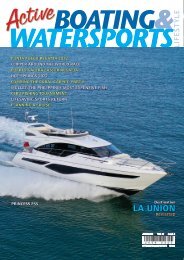ABW Sept 2020
You also want an ePaper? Increase the reach of your titles
YUMPU automatically turns print PDFs into web optimized ePapers that Google loves.
Sail power<br />
By the time of the Bronze Age, ships were being made of<br />
planks nailed together, and the concept of the sail had been<br />
introduced. The first sailing boats are thought to be on the<br />
lines of the model ship discovered in a tomb in Egypt in 1906.<br />
Dating from 2400BC, and rigged with<br />
a single square-sail mounted on a<br />
short central mast, the boat was<br />
steered by a large paddle shaped oar<br />
strapped to the stern of the boat.<br />
The Egyptians retained this form of<br />
ship for some time, and the Egyptian<br />
square-sail rig spread eastward – it<br />
is still seen today around the waters<br />
of Malaya. The Lateen sail was also,<br />
presumably, an Egyptian invention.<br />
A trapezoidal with a short luff. It was<br />
bent to a yard arm, set obliquely to<br />
the mast. The design was revolutionary in that it enabled the<br />
boat to sail towards the wind to some extent, as well as away<br />
from it. The precursor of the fore-and-aft rig adopted by<br />
most modern cruising boats, the lateen sail is still used today<br />
by Arabian dhows. A slightly different, squarer form, known<br />
as the lugsail, was developed by the Chinese. It consisted of<br />
a single sail, made up in sections, stiffened by bamboos and<br />
is also still in use, known as the junk rig. Like the lateen, it<br />
is bent to q yard, but then slung towards the leeward of the<br />
mast when hoisted and set, with its tack forward of the mast.<br />
The lugsail is practical in that it can be easily handled and<br />
reefed.<br />
and ketches all plied the coastlines of Europe, each designed<br />
for a particular purpose – the type of cargo carried or the type<br />
of waters sailed in.<br />
By the 19th century, the large cargo boats had been much<br />
modified and streamlined.<br />
Competition on the trade routes<br />
to the Far East and to Australia<br />
inspired the boat designers to<br />
find important rigs to increase<br />
speed and efficiency. One of<br />
the most revolutionary was the<br />
clipper design originating in the<br />
states, of which the Rainbow, built<br />
in 1845, was a prime example.<br />
“The vessel will never be built to<br />
beat her,” declared the skipper.<br />
His confidence although proved<br />
wrong some half a century later, was not surprising. The<br />
clippers could cut the sailing time of other vessels down<br />
by half. Their design was based on that of the Chesapeake<br />
working boats, with a very narrow bow, a streamlined hull and<br />
a combination of the fore-and-aft and square rig. With the<br />
Early boatbuilders realized<br />
that the efficiency of<br />
the sail was directly<br />
proportional to its size<br />
and the larger the sail a<br />
boat could carry the faster<br />
it would travel.<br />
Staysail Schooner<br />
To understand the design of modern sailing craft, it helps<br />
to know something of the development of the original hull<br />
constructions and types of rig, as many of these aspects of<br />
these ancient forms have been incorporated in modern designs.<br />
Then, as now, one of the main concerns of boat builders was<br />
for speed. Early boatbuilders realized that the efficiency of the<br />
sail was directly proportional to its size and the larger the sail<br />
a boat could carry the faster it would travel. However, large<br />
sails were both unwieldy and uneconomical to use, except in<br />
parts of the world where labour was cheap. Boat builders in the<br />
Western World in Particular, resolved the problem by splitting<br />
the canvas area into several smaller sails carried on more than<br />
one mast. This square rig, with a beamy, sturdy hull and a high<br />
freeboard, was for many centuries in Europe, the preferred boat<br />
design for large cargo boats. As new oceans were discovered<br />
and mapped they were built in ever-increasing numbers to take<br />
advantage of the new markets.<br />
Around the coastlines of the northern countries of Europe,<br />
however, different considerations applied, and the variety<br />
of rigs which developed to meet specific local needs were<br />
numerous. Although the square-rigged ships, were suited<br />
to sailing downwind, could exploit the steady breezes of the<br />
trade winds, the craft plying coastal waters needed a more<br />
adaptable rig. A combination of the square rig with a foreand-aft<br />
one (a modification of the lateen sail) was developed<br />
which allowed the boats to sail well toward windward. Barques<br />
and barquentines, brigs and brigantines, snows, schooners<br />
advent of the industrial revolution, the first experiments with<br />
powering ships with steam engines were to be made. These<br />
early vessels were unreliable and much scorned by the sailing<br />
masters, but by the turn of the century, steam had overtaken<br />
sail for many of the large cargo and passenger boats, and in<br />
the years that followed only small fishing and working boats<br />
still operated under sail power alone.<br />
By the early part of the 20th century, engine power had<br />
virtually eclipsed the use of sail. However, people were<br />
beginning to turn to sailing for recreation and pleasure,<br />
and the now redundant sail-powered working boats were<br />
occasionally converted into cruising boats. Since those times<br />
the art of sailing has been kept alive by enthusiastic amateurs.<br />
Thanks to the increase in popularity of various forms of racing<br />
boat design has been modified and improved to make boats<br />
not only safer and faster, but easier to handle. The double<br />
advantage of both adventure and a sense of freedom has<br />
spurred many thousands of people to take to small boats, and<br />
to cruising in particular, all over the world.<br />
75


